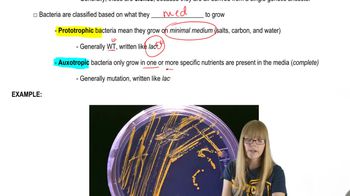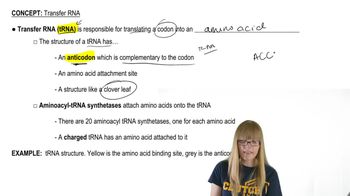Which of the following is NOT a way scientists can phenotypically identify a bacterial mutation?
Table of contents
- 1. Introduction to Genetics51m
- 2. Mendel's Laws of Inheritance3h 37m
- 3. Extensions to Mendelian Inheritance2h 41m
- 4. Genetic Mapping and Linkage2h 28m
- 5. Genetics of Bacteria and Viruses1h 21m
- 6. Chromosomal Variation1h 48m
- 7. DNA and Chromosome Structure56m
- 8. DNA Replication1h 10m
- 9. Mitosis and Meiosis1h 34m
- 10. Transcription1h 0m
- 11. Translation58m
- 12. Gene Regulation in Prokaryotes1h 19m
- 13. Gene Regulation in Eukaryotes44m
- 14. Genetic Control of Development44m
- 15. Genomes and Genomics1h 50m
- 16. Transposable Elements47m
- 17. Mutation, Repair, and Recombination1h 6m
- 18. Molecular Genetic Tools19m
- 19. Cancer Genetics29m
- 20. Quantitative Genetics1h 26m
- 21. Population Genetics50m
- 22. Evolutionary Genetics29m
5. Genetics of Bacteria and Viruses
Working with Microorganisms
Problem 4b
Textbook Question
Fifteen bacterial colonies growing on a complete medium are transferred to a minimal medium. Twelve of the colonies grow on minimal medium.
The three colonies that do not grow on minimal medium are transferred to minimal medium supplemented with the amino acid serine (min + Ser), and all three colonies grow. Characterize these three colonies.
 Verified step by step guidance
Verified step by step guidance1
Identify the key difference between the complete medium and the minimal medium. The complete medium contains all necessary nutrients, while the minimal medium contains only the essential nutrients required for bacterial growth.
Analyze the observation that 12 out of 15 colonies grow on the minimal medium. This indicates that these 12 colonies can synthesize all the necessary compounds for growth from the nutrients provided in the minimal medium.
Focus on the 3 colonies that do not grow on the minimal medium. This suggests that these colonies are auxotrophic for a specific nutrient, meaning they lack the ability to synthesize a particular compound required for growth.
Examine the result of transferring the 3 non-growing colonies to the minimal medium supplemented with serine. Since all three colonies grow in this condition, it indicates that these colonies are specifically auxotrophic for serine. They cannot synthesize serine on their own and require it to be provided externally.
Characterize the three colonies as serine auxotrophs. This means they have a genetic mutation or defect in the biosynthetic pathway for serine, preventing them from producing this amino acid independently.
 Verified video answer for a similar problem:
Verified video answer for a similar problem:This video solution was recommended by our tutors as helpful for the problem above
Video duration:
3mPlay a video:
Was this helpful?
Key Concepts
Here are the essential concepts you must grasp in order to answer the question correctly.
Minimal Medium
Minimal medium is a growth medium that contains only the essential nutrients required for the growth of microorganisms, such as carbon, nitrogen, and salts. It lacks additional growth factors, such as amino acids or vitamins, which some organisms may need to survive. In this context, the ability of bacterial colonies to grow on minimal medium indicates their metabolic capabilities and nutritional requirements.
Recommended video:
Guided course

Conjugation Overview
Amino Acid Supplementation
Amino acid supplementation involves adding specific amino acids, like serine, to a growth medium to support the growth of organisms that cannot synthesize these compounds. The three colonies that failed to grow on minimal medium likely have mutations affecting their ability to produce serine, making them auxotrophic. By supplementing the medium with serine, these colonies can thrive, demonstrating their dependency on external sources of this amino acid.
Recommended video:
Auxotrophy
Auxotrophy refers to the condition of an organism that cannot synthesize a particular compound required for its growth due to a mutation. In this case, the three bacterial colonies are auxotrophic for serine, meaning they lack the genetic capability to produce it. This characteristic is crucial for understanding their growth requirements and metabolic pathways, as it highlights their reliance on external sources of nutrients.
Recommended video:
Guided course

Bacteria in the Laboratory

 9:35m
9:35mWatch next
Master Bacteria in the Laboratory with a bite sized video explanation from Kylia
Start learningRelated Videos
Related Practice
Multiple Choice
437
views
3
rank

